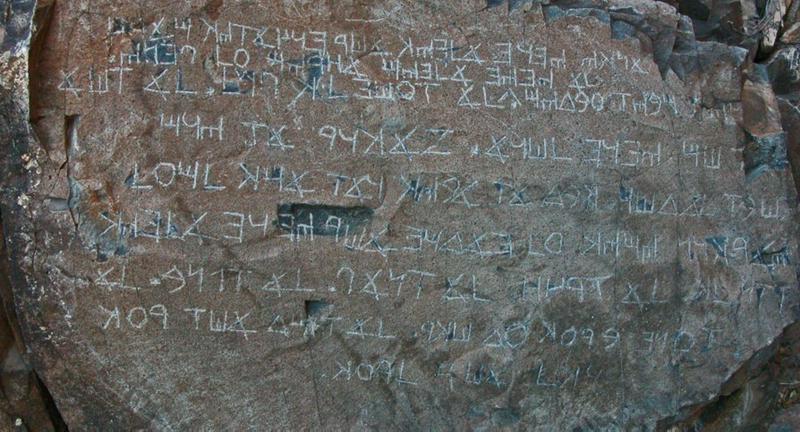The Ten Commandments In The New Mexico Desert
By | April 23, 2019

Deep in the desert of New Mexico, near the town of Los Lunas, about 35 miles south of Albuquerque, is a strange, carved stone that some people claim is evidence that the Lost Tribe of Israel somehow made their way to the New World and journeyed into the American Southwest. As improbable as this sounds, the tangible proof is there for all to see…carved onto a large boulder that has come to be known as the Los Lunas Decalogue Stone. Is this stone genuine proof of a Jewish presence in pre-Colombian America? Or, as critics claim, a modern-day hoax? Let’s look at both sides of the story.

The Stone’s Discovery
Oral stories claim that the people knew about the Los Lunas Decalogue Stone as far back as the 1850s, but at least one person, Franz Huning, claimed in 1871 that local Native Americans informed him that the stone was already there when their ancestors arrived in the region. Official credit to discovering the stone goes to Frank Hibben, a professor at the University of New Mexico. Hibben was shown the rock by a local resident of the area who says he had learned about the carved stone when he was a child, back in the 1880s. Hibben claims that when he found the rock, it was covered in lichen and near indistinguishable from other rocks in the area.

The Stone’s Carvings
The 80-ton Los Lunas Decalogue Stone is carved on one flat side with a passage from Exodus in the Hebrew Old Testament listing the Ten Commandments and paleo-Hebrew writing. Hibben and others dated the stone carvings to more than 1500 years before Columbus visited the New World and offered it as proof that Jewish travelers, possibly the Lost Tribe of Israel, made it to the American Southwest. A mineralogist named George Morehouse examined the carvings on the stone in 1985 and concluded that the engravings were between 500 and 2,000 years old, based on weathering patterns.

A Plausible Theory
We now know that Christopher Columbus was not the first European to set foot in the Americas. There were voyages to the New World by Vikings, Middle Easterners, and possibly travelers from Asia. It is not impossible that Hebrew sailors made it safely across the Atlantic and into the Gulf of Mexico. Perhaps they were aided by indigenous people who guided them further inland. And there have been other clues that some of the native tribes of North America had contact with Hebrews in antiquities, though that remains to be proven. Perhaps the Los Lunas Decalogue Stone is the proof that’s needed.

Clues in the Inscription
The Ten Commandments are carved into the stone in a neat Paleo-Hebrew script. Similar to the Phoenician alphabet, Paleo-Hebrew is an early form of Hebrew writing. The Gezer calendar, which dates to the 10th century BC, is the earliest known example of Paleo-Hebrew writing. There are some anomalies on the Los Lunas Decalogue Stone’s inscription, though. Experts in ancient languages have pointed out that some of the letters are ancient Greek and there is at least one use of an archaic Hebrew letter.

An Elaborate Hoax?
Many experts, however, doubt the stone’s authenticity. One big reason for this is Professor Hibben’s lack of credibility. On at least two other occasions, Hibben was caught fabricating his finds to support his personal theories. Could the Los Lunas Decalogue Stone be one more example of Hibben’s false archaeology?

Could Grammar Errors Indicate a Hoax?
Although the bulk of the Los Lunas Decalogue Stone is written in Paleo-Hebrew, there are some notable errors in the text that have sent up some red flags for researchers. For example, there are a few symbols on the inscription that were not used in Hebrew writing until the late medieval era. Additionally, whoever carved the stone used the Paleo-Hebrew letter “Aleph” as a vowel even though it was a consonant in the ancient language. Other letters were used interchangeably, despite representing individual sounds. If the stone was carved by a native speaker, these mistakes would not have occurred. Critics of the stone’s authenticity claim that it was carved by someone with only a cursory understanding of Paleo-Hebrew.

A Clue in the Word Order
A few of the researchers who have studied the stone believe that the word order on the inscription provides a clue to the age of the carvings. They claim that the author of the stone lived in the Byzantine era and they point to both the word order and the word spellings on the stone to show that they are consistent with writing from that time period. There are, however, a few clues that point to a post-Medieval time period.

An Isolated Stone
One other clue that seems to indicate that the Los Lunas Decalogue Stone is a hoax comes not from the stone, but from the area surrounding it. To date, no other evidence has been unearthed to show that a Hebrew population existed in the American Southwest in ancient times. The Spanish and the Vikings, for example, left behind artifacts and structures to tell us of their presence, but none of this exists in the area around Hidden Mountain in New Mexico.

Inconclusive
Currently, most scholars have dismissed the Los Lunas Decalogue Stone as a hoax, but others are not so quick to write it off. They believe a most exhaustive study of the stone needs to be done to definitively determine the date it was carved. They also believe that scholars should look at the native tribes of the region to see if their ancient legends and modern-day DNA indicated that they had contact with Jewish people hundreds of years ago.

